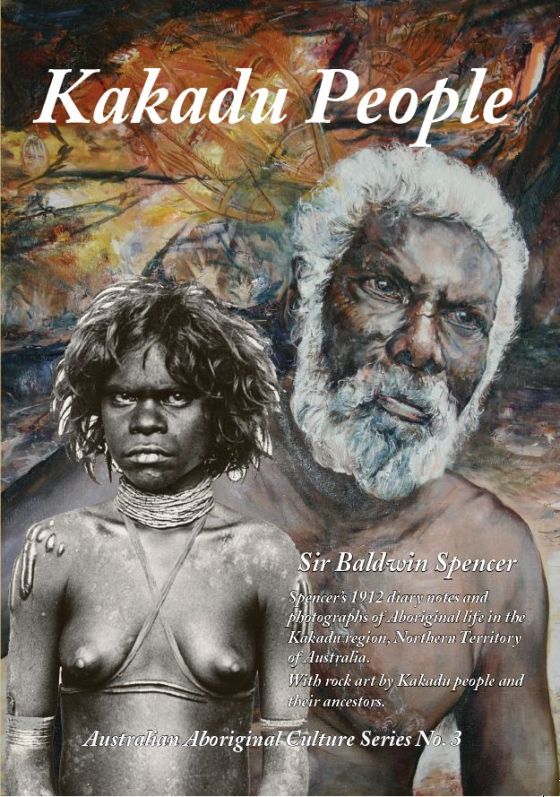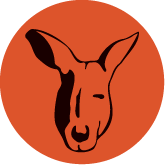AUSTRALIAN ABORIGINAL CULTURE SERIES N0. 3
Kakadu People
By Sir Baldwin Spencer
ISBN 9780977503537
Published by David M. Welch 2008
Format: Paperback
272 pages with 204 illustrations. These include 106 colour photos of local rock art, artefacts and people, 91 historic black and white photos, and 7 drawings, including 2 maps.
Click here for a list of booksellers who stock this title.
Introduction:
Kakadu people (also spelt Gagudju) were a tribe – or language group – of Australian Aborigines living along the East Alligator River when Baldwin Spencer visited that part of the Northern Territory of Australia in 1912.
Sir Walter Baldwin Spencer (1860-1929) was professor of biology at the University of Melbourne when he was appointed Chief Protector of Aborigines for the Northern Territory, to be based in Darwin. This book contains his diary notes, photographs and sketches compiled while conducting field work in the East Alligator River region.
In Part One, Spencer describes his work in Darwin as Chief Protector of the Aborigines, recounting how Aboriginal people were perceived as needing protection from the European, Chinese and Malay populations living in the Northern Territory. Although not directly relating to Kakadu people, this section of Spencer’s writing is important historically, setting the scene for life as it was when he visited the Kakadu people.
In Part Two, Spencer meets Paddy Cahill at Oenpelli (now known as Gunbalanya) near the East Alligator River, staying from June 20th to August 8th 1912. While there, he makes extensive notes about Aboriginal life, takes photographs, and collects Aboriginal artefacts and animal specimens for the National Museum in Melbourne.
Spencer writes, “the Kakadu is one of a group, or nation, of tribes inhabiting an unknown extent of country, including that drained by the Alligator Rivers, the Coburg [Cobourg] Peninsula, and the coastal district, at all events as far west as Finke Bay… For this nation, I propose the name Kakadu, after that of the tribe of which we know most.” The term Kakadu People is used by him in his 1928 two-volume set, Wanderings in Wild Australia, which records his time on the East Alligator River in 1912. Most of the text in Parts One and Two is taken from this.
In Part Three, additional material regarding the Kakadu and the nearby Iwaidja (Spencer spelt both Iwaidja and Iwaidji), Umoriu, Geimbio and Kulunglutji tribes is taken from Spencer’s 1914 work, Native Tribes of the Northern Territory of Australia. His research material, with expanded details about the five most important ceremonies, is included here.
Paddy Cahill, a buffalo shooter with whom Spencer stayed, came to the area in 1891 and established his station at Oenpelli, about ten kilometres east of the East Alligator River, in 1906. Oenpelli was gazetted as a government reserve in 1920 and became a Church Missionary Society mission in 1925.
Spencer noted two camps at Oenpelli, “one belonging to the local people, with whom also were men of the Umoriu and Geimbio tribes,” and the other, “belonging to visitors from theKulunglutji tribe, inhabiting the King River country away to the east.” The Kakadu tribe were part of the “local people” which also included other groups such as the Mengerr, not mentioned by Spencer, but who are now known as the traditional owners of Injalak.
Following Spencer’s visit, the population of the Kakadu people decreased. Spencer recorded the arrival into the region of groups from the east. In 1916 Cahill noted the arrival of 500 people from the Liverpool River area, followed by another 250 people (Cahill’s letters, quoted in Schrire 1982: 26). By 1918 Paddy Cahill was treating many people for fever, influenza, venereal disease, skin and eye infections, trauma, asthma and yaws, and he noted in 1921 that very few children were being born to the Kakadu people. Over time, Kakadu people became absorbed into other groups, migrated towards buffalo stations and died from diseases brought into the area by Europeans and Chinese.
When I first visited the Kakadu area in 1979, Kakadu people had almost completely disappeared, some clans having died out and others having only a few remaining members. There was a small family group at Cannon Hill (Big Bill Neidjie and his family) and some Kakadu speaking people at Mudginberry and at Oenpelli. Further south, small family groups from other tribes (language groups) were living at the entrance to Deaf Adder Gorge and near Nourlangie Rock.
The largest group of people living at Oenpelli were the Gunwinggu tribe or language group, who had migrated from the Liverpool River district in the north-east. That name is not mentioned in Spencer’s account, though he does refer to the Kulunglutji tribe as originating from the King and Liverpool Rivers, and also inhabiting the country at the headwaters of the East Alligator River (see map). Today the Kulunglutji tribe is extinct, but it may have consisted of an early group of Gunwinggu-related people.
By the 1970s, there were six language groups in the region around the East Alligator River (Peter Carroll quoted in Schrire 1982: 24). Four groups found on the plains were Mengeridji (or Mengerdji) at Oenpelli, Ere (Erre) and Uningangg between Oenpelli and the East Alligator River, and Gagadu (Kakadu) on the western bank. Two groups on the plateau country were Gunwinjgu (Gunwinggu) east of Oenpelli and Djeibmi (Gunjepmi) further south.
Kakadu National Park was proclaimed on 5th April 1979. The East Alligator River serves as the boundary between the national park to the west and Arnhem Land to the east.
In general, Australian tribes or language groups can be divided into smaller land-owning groups, called clans. The clans in this region, called gunmogurrgurr, overlap in both their territories and in the fact that members of each may originate from different areas and language groups, consequently, the clans are multilingual. What defines each gunmogurrgurr is both its shared territory and the inheritance of the group leader, who has a responsibility and relationship to that land through the dreaming paths of the mythical Ancestral Beings inhabiting his land.
Big Bill Neidjie, who features on the cover of this book, was a member of the Bunitj clan, one of the two gunmogurrgurr groups in the East Alligator region. Bunitj’s territory included the plains of the East Alligator River and Magela Creek, encompassing the area around Cannon Hill and Ubirr (Obiri Rock), and included people who spoke Kakadu, Wardadjbag, Minjdjarra and Ngardok. Big Bill lived at Cannon Hill and was also known as the “Kakadu Man,” taken from the title of his book. He actively helped me with my rock art research on his lands from 1979 to 1988 and he died in 2002, aged in his 80s. If he were still alive, he would be proud to know his image is with this book. Heather Riley painted the two portraits and when Bill saw the finished painting of himself sitting at Ubirr, he asked her to show his painting to as many people as possible. That was his wish.
The girl on the cover, photographed by Paul Foelsche in the 1880s, is believed to also be from the East Alligator River.
The other gunmogurrgurr group in the East Alligator River region is Mirarr (or Mirrar), whose territory is to the east, overlapping with Bunitj at Cannon Hill and Ubirr. Mirarr people spoke Kakadu, Mengerrdji and Maiali (Gunjemi or Gunjepmi). There were originally over twenty clan groups in the area of what is now Kakadu National Park, stretching from the West Alligator River to the East Alligator River and south to the Mary River and Katherine River.
While many tribes (language groups) in Australia had reasonably defined boundaries such as a river, mountain range or other land feature, the language groups of this area were less defined. Intermarriage, overlapping boundaries, the movement of people through the cycle of the seasons to high ground in the wet season and back down to the flood plains in the dry season when all the birds and other animals congregated around the receding waters, contributed to this. The Kakadu people and neighbouring tribes were multilingual, mobile hunter-gathers, sharing language and territory, moving with the changing seasons, and at the same time, having spiritual ties to their lands.
In relation to the original population numbers, each clan consisted of 30 to 40 people and on one occasion in 1845 the explorer Leichhardt noted a tribe with about 200 members gathering together. Since the 1970s, Aboriginal people have returned to the Kakadu region and consequently their numbers have increased. The main languages now spoken are Gunwinggu (Kunwinjku) from the north-eastern region, Gundjeihmi (Gunjepmi) from the centre and Djauan (Jawoyn) from the south. Current spellings differ because, firstly, different linguists and researchers write Aboriginal word sounds in different ways, secondly, there are variations in speech and dialects between different Aboriginal people, especially when describing the names of groups other than their own, and thirdly, word sounds change over time.
The “dj” sound is sometimes written “j” or “ch” and for Aboriginal languages, “k” and “g” sounds, such as in the word “Kakadu” are interchangeable. The “a” sound in “father” is now written as “a” but has been written “u” in the past. The “oo” sound in “good” is written as “u.”
At the time of Spencer’s writing, the didgeridoo was called a “trumpet,” Spencer preferring the term “conch.” The fish we know today as a “barramundi” was sometimes called a “barramunda,” a name applied to three different fish. In compiling this new edition of Spencer’s work, I have assisted the reader by adding either footnotes with the notation, “Ed.” or a brief alternative in square brackets where spellings or names have changed or are no longer in common usage. Even place names may alter and acquire different spellings over time. The name of the hill overlooking Oenpelli/Gunbalanya was written as “Unbalanja” in the 1940s, “Inyalak” in the 1970s and “Injalak” in the 1990s. The captions to Spencer’s original photographs have sometimes been expanded with additional information, and captions for other images are my own comments. All black and white photographs are Spencer’s unless otherwise noted at the side.
For thousands of years, people of the Kakadu region recorded their own culture on the walls and ceilings of cliff edges and rock shelters, and examples of this rock art are included here. I have also added colour images of local Aboriginal artefacts and scenery. These include some of the bark paintings and bags Spencer and Cahill collected, a selection of artefacts acquired by Paul Foelsche and others in the 1870s and 1880s, and additional artefacts from my own collection.
Spencer’s careful observation and documentation give us a unique picture of Aboriginal life in northern Australia. I have chosen not to exclude any of his material. Some readers may criticise my decision to include Spencer’s records of secret and sacred objects and ceremonies. However, I am of the firm belief that its presence is essential for an appreciation of the richness of Aboriginal customs and art. The incorporation of Kakadu rock art images further enhances Spencer’s text and promotes a true understanding of Aboriginal culture.
David M. Welch, Darwin 2008
Contents
Introduction
Author’s biography
Acknowledgments and references
Part One – Work in Darwin
From Darwin to the East Alligator River by sea
Huge bush fires
Part Two – The East Alligator River and the Kakadu tribe
Paddy Cahill and Oenpelli
The Kakadu tribe and Muraian ceremonies
Kangaroo men
Wuraka and Imberombera – important Ancestral Beings who created Tor rock and spirit-children.
Spirit-children and reincarnation
Evil magic by means of burning korno or excrement
Evil magic causing disease
A magical ceremony to strengthen a boy who is weak and undergrown
The fish, Nuppadaitba, and evil magic
Other magic on food
Death of a woman and a Burial Ceremony
Prelude to initiation ceremonies
Kakadu ceremonies
Jeru Ober, the Ancestral Kangaroo-Man
Purification ceremony following a woman’s death – smoking and water-pouring
Hunting and food gathering
Cooking
Numereji, the Ancestral snake and the Medicine Men
The two brothers who were Numereji Men – Snake Men
Joemin, the first Medicine Man, and the making of Medicine Men
Bark paintings and drawings
Marriage arrangements
Spearing Barramundi
Kakadu Spears Restrictions on eating snakes
Tradition of Bubba Peiba
Nangintain the mischievous spirit
Tradition of a Snake Man named Ngabadaua and two Snake Women named Narenma
Lubra sending the salt water back
Tradition of Eribinjori, the Crocodile
Totemic names
Yalmuru and Iwaiyu, a person’s spirit and shadow spirit
Second part of the Mourning Ceremony, Morlil
The third Mourning Ceremony, Kuderi
Barter
Rock shelters containing art
A black kangaroo
A woman’s dillybag containing the bones of her dead child
The Muraian Ceremonies – increase ceremonies
The origin of the Muraian sacred objects
Clubs used by the Kakadu tribe
Stone and shell implements
Bags and baskets
The conch or trumpet (didgeridoo)
Various articles used by the Kakadu tribe
Challenge Sticks – Medjingeli, Spindle, Rasp, Fan, Beeswax and Abrus seed pendants
Corroboree wands – Yai-illa
Clothing
Kangaroo teeth head ornaments
Bark waist-belts
The night sky
Part Three – Further notes on ceremonies and customs of the Kakadu tribe
The initiation ceremonies of the Kakadu tribe
- The Jamba Ceremony
- The Ober Ceremony
- The Jungoan Ceremony
- The Kulori (Yam) Ceremony
- The Muraian Ceremony
Tradition of Ungulla who left children across the land south and west of the Kakadu people
A mischievous spirit enticing a native away
Rain making in the Kakadu tribe
Restrictions on speaking
Navel string or Worlu
Child born dead
The rainbow
Menstrual flow
Sticks given to a woman when enceinte (pregnant)
Nose boring
Beliefs with regard to animals
Naming of children
Food restrictions amongst the Kakadu people
Food restrictions for women
Fire making Two methods of cooking – open fire and earth oven
The Thunder Man and the formation of cupules in the rocks
Sun, moon, and stars









